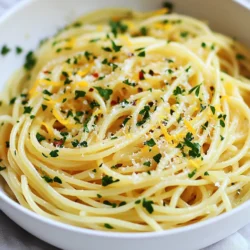
Garlic Olive Oil Spaghetti
A simple and flavorful spaghetti dish with garlic, olive oil, and a hint of spice.
Ingredients
- 200 g spaghetti
- 4 cloves garlic, thinly sliced
- 60 ml extra virgin olive oil
- 1 teaspoon red pepper flakes (adjust to taste)
- 0.25 cup fresh parsley, chopped
- 1 unit zest of 1 lemon
- to taste salt
- optional freshly grated Parmesan cheese
Instructions
- Bring a large pot of salted water to a boil. Once boiling, add the spaghetti and cook according to package instructions until al dente. Reserve 1/2 cup of pasta water, then drain the spaghetti.
- In a large skillet over medium heat, add the extra virgin olive oil.
- Once the oil is warm, add the thinly sliced garlic and red pepper flakes. Cook gently for about 2-3 minutes, stirring frequently, until the garlic is golden and fragrant but not browned.
- Add the drained spaghetti to the skillet, tossing it in the garlic-infused olive oil. If the pasta seems dry, add a little reserved pasta water to achieve the desired consistency.
- Remove from heat and stir in the chopped parsley and lemon zest. Season with salt to taste.
- Serve immediately with freshly grated Parmesan cheese on top, if desired.
Notes
Serve the spaghetti in a deep bowl, garnished with a sprinkle of extra parsley and a twist of lemon zest on top for a pop of color.